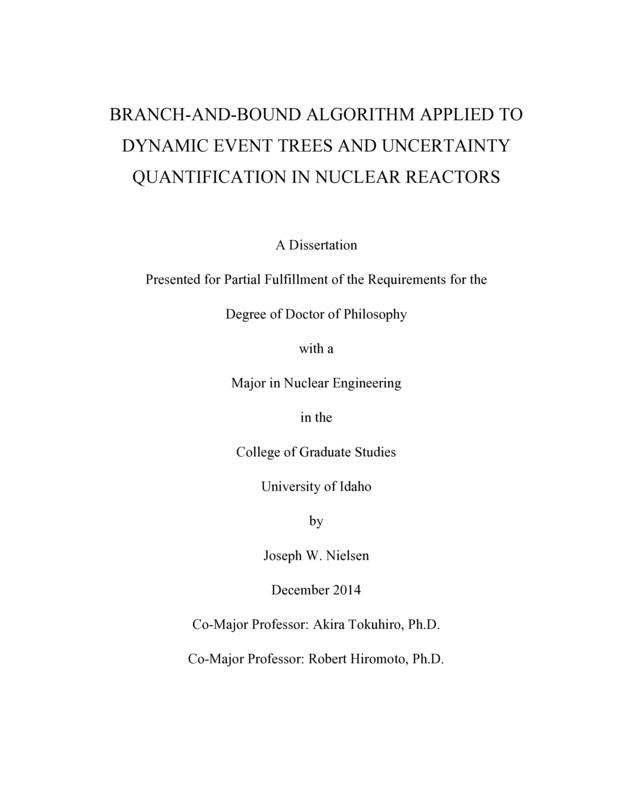BRANCH-AND-BOUND ALGORITHM APPLIED TO DYNAMIC EVENT TREES AND UNCERTAINTY QUANTIFICATION IN NUCLEAR REACTORS
Nielsen, Joseph W.. (2014). BRANCH-AND-BOUND ALGORITHM APPLIED TO DYNAMIC EVENT TREES AND UNCERTAINTY QUANTIFICATION IN NUCLEAR REACTORS. Theses and Dissertations Collection, University of Idaho Library Digital Collections. https://www.lib.uidaho.edu/digital/etd/items/nielsen_idaho_0089e_10425.html
- Title:
- BRANCH-AND-BOUND ALGORITHM APPLIED TO DYNAMIC EVENT TREES AND UNCERTAINTY QUANTIFICATION IN NUCLEAR REACTORS
- Author:
- Nielsen, Joseph W.
- Date:
- 2014
- Keywords:
- Branch and Bound Dynamic Event Trees Dynamic Probabilistic Risk Assessment LENDIT S2R2
- Program:
- Mechanical Engineering
- Subject Category:
- Nuclear engineering
- Abstract:
-
Probabilistic Risk Assessment (PRA) is an important tool for evaluating risk in nuclear power plants. Dynamic PRA is an extension of traditional PRA methods that account for dynamic and phenomenological effects associated with the complex dynamic systems. This research focuses on dynamic event trees and addresses optimization in identifying the highest probability of system failure. The Branch-and-Bound algorithm is applied to dynamic event trees for nuclear power plants. The Branch-and-Bound algorithm relies and development of bounding functions to prune or delete branches that will not yield the optimal solution (i.e., clad failure). This research demonstrated the use of LENDIT metrics and S2R2 sets to support an expert-based approach to developing bounding constraints for the use of the Branch-and-Bound algorithm as applied to dynamic event trees. The use of the Branch-and-Bound algorithm has been shown to be effective in reducing simulation time. In addition, the optimized dynamic event trees are evaluated with respect to modeling uncertainty within the simulation code. This research demonstrates the ability to evaluate modeling uncertainty and develop a risk-informed Phenomena Identification and Ranking Table (PIRT). This PIRT can be used to improve thermal-hydraulic models and identify validation needs with respect to risk.
Two case studies, one for a Pressurized Water Reactor and a Boiling Water Reactor station blackout scenario are evaluated. The implementation of the Branch-and-Bound algorithm has been demonstrated to reduce simulation costs by more than 60% for these two case studies. The PIRT ranking for parameters important to cold safe shutdown of both reactor type transients was evaluated. The PWR station blackout scenario demonstrated that low fidelity models combined with system redundancy produces adequate results with respect to risk. Within in the BWR blackout condition, the modeling uncertainty does not present a challenge with respect to risk. Recovery of the station blackout transient requires either restoration of the AC power or activation of firewater injection combined with operator action to depressurize the system through the automatic depressurization system. Reactor power and firewater injection capacity provided the highest degree of correlation to model success.
- Description:
- doctoral, Ph.D., Mechanical Engineering -- University of Idaho - College of Graduate Studies, 2014
- Major Professor:
- Tokuhiro, Akira; Hiromoto, Robert
- Committee:
- Mandelli, Diego; Smidts, Carol
- Defense Date:
- 2014
- Identifier:
- Nielsen_idaho_0089E_10425
- Type:
- Text
- Format Original:
- Format:
- application/pdf
- Rights:
- In Copyright - Educational Use Permitted. For more information, please contact University of Idaho Library Special Collections and Archives Department at libspec@uidaho.edu.
- Standardized Rights:
- http://rightsstatements.org/vocab/InC-EDU/1.0/

